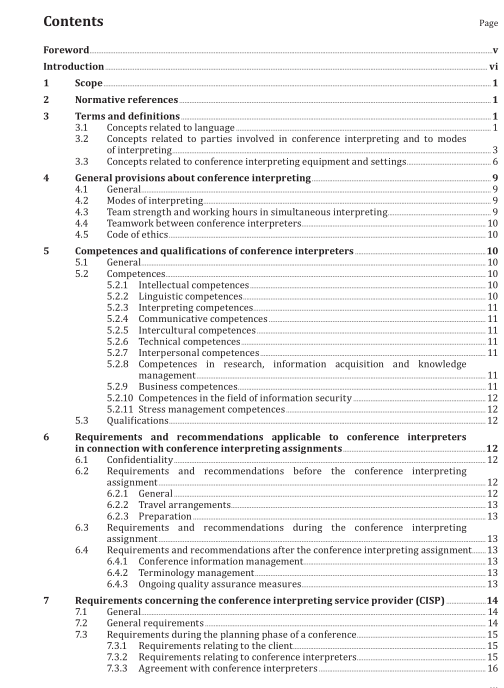ISO 23155:2022 pdf download.Interpreting services — Conference interpreting — Requirements and recommendations
4 General provisions about conference interpreting
4.1 General
Conference interpreting is provided at bilingual and multilingual conferences to facilitate communication between participants using different spoken or signed languages. Conference interpreters shall have two or more working languages, classified as ‘A’ languages, ‘B’ languages, or ‘C’ languages, according to their level of proficiency.
Conference interpreters interpret from all their working languages into their ‘A’ languages and from their ‘A’ languages into their ‘B’ languages. Conference interpreters can either be staff interpreters, who are employed on an open-ended or fixed- term contract, or self–employed interpreters who carry out conference interpreting assignments on the basis of individual contracts.
Conference interpreting is an intellectually demanding activity and assignments can be particularly strenuous owing to specific characteristics, such as the level of technical detail. Coping with stress is inherent to conference interpreting.
Distance interpreting can entail increased cognitive load, which requires additional intellectual effort and increases stress.
4.2 Modes of interpreting
Conference interpreters interpret in simultaneous or consecutive interpreting mode, depending on the needs of the conference and the infrastructure and technical options available. In consecutive interpreting no equipment is generally required, while simultaneous interpreting is provided from booths, using equipment including interpreter interfaces, screens, headphones and microphones. Exceptionally, simultaneous interpreting can also be provided using portable interpreting systems, for example during itinerant events or site inspections. In simultaneous interpreting, conference interpreters select an incoming channel to listen to a source language and their rendition is transmitted on an outgoing channel.
Conference interpreters interpreting into the same language, using the same outgoing channel, should sit in the same booth; however, such outgoing channel can be temporarily used by interpreters working at the same conference sitting in other booths for the purposes of retour. See 4.4 for additional provisions. In whispered interpreting, conference interpreters interpret in the simultaneous mode without using interpreting equipment but can use headphones to listen to the speaker or an outgoing channel. Signed language interpreters interpret in the meeting room, facing the audience, or in a booth or other dedicated space.
4.3 Team strength and working hours in simultaneous interpreting The composition and organization of interpreting teams, as well as the working hours of conference interpreters, including breaks, have an impact on the quality of conference interpreting.
Conference interpreters shall work in teams of at least two interpreters per booth. In exceptional cases, a conference interpreter may work alone for a maximum of 45 min. This can be reduced if warranted by the language combination or the degree of difficulty of the assignment.
The number of conference interpreters in a team of conference interpreters primarily depends on the number of languages used at the conference, as well as on its duration and difficulty. Good results have been achieved with the team strengths recommended in Annex E.
Given health and quality considerations, an interpreter’s working day should not exceed two sessions of 3,5 h each, separated by a break of 90 min.
Working hours and breaks are among the basic elements of agreements that govern conference interpreting assignments (see Annex C). Staff and self-employed conference interpreters working for government departments or international organizations can be subject to a legal act or collective agreement governing contractual relations, including working hours and work organization.
Distance interpreting can entail additional cognitive load and stress for conference interpreters,accelerating the onset of fatigue. In planning assignments involving distance interpreting, the client and the CISP should take mitigating measures, including shorter sessions, more frequent or longer breaks or increasing team strength.
4.4 Teamwork between conference interpreters
Continuous communication and coordination are necessary between conference interpreters interpreting at a conference.
In simultaneous interpreting, conference interpreters interpreting into the same outgoing channel shall be able to communicate with each other visually and orally to:
— support each other when numbers, acronyms, technical terms or proper names are read out at speed;ISO 23155 pdf download.ISO 23155 pdf download
